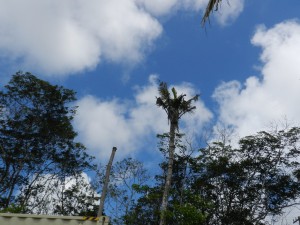Majority of America just sees coconuts as something fun to drink when in the tropics, a super health food, sprinkles on doughnuts and cakes, and something that looks like a monkey if held at the right angle.
To my family, and our culture at large, they are many things;
(Responses my grandfather, Roque and his brother, Mark, tell me after asking them about the utility of the coconut and it’s tree)
“The green is used for drinking and eating.”
“The brown, older one is used for eating and cooking. That’s the one for oil and milk. Then that’s the one that we use the shell for. And the husk is used for burning and repelling mosquitoes.
“When the fallen ones take root and they start producing a stalk (he points to the left picture above), you chop off that stalk and chew on the end. It’s sweet. Then, you crack the inside and eat the fa’ha. It’s tangy and has the texture of spongecake.”
I ask to try, but they say no. I ask why and they point up to a dying tree.
“Because of the rhinoceros beetle.”
“The department of agriculture estimates 50-80% of our trees will be dead in the next 15 years.”
I am skeptical of that number myself, but as I look around the property, I can see how they got those numbers.
“The trees are sick and it’s already too late for some. So we’re not eating the young ones. We only pick a few of the brown and we let the fallen grow.”
—
I remember the last time I was here that I saw a few trees here and there infested. As a weaver, I felt sad. Although, this time around I am absolutely heart broken. Now it seems that the healthy ones are the ones that are few and far in between.


Leave a Reply